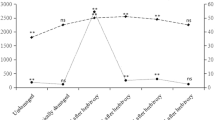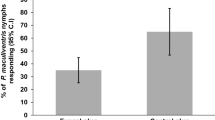Summary
Adults of the predatory beetleRhizophagus grandis are strongly attracted to both adult and larval frass of its specific prey,Dendroctonus micans, in walking bioassays. Spruce bark and resin are relatively unattractive. Solvent extracts of larval frass that were attractive toR. grandis adults in a flight wind tunnel contained a mixture of monoterpenes of host plant origin. A synthetic mixture of these monoterpenes, (+)—α-pinene, (−)—β-pinene, β-phellandrene,dl limonene and 3-carene, was responsible for 70–80% of the activity of the most attractive extract. We suggest that a blend of monoterpenes in frass acts as a kairomone forR. grandis but that attraction to monoterpenes is only the first of a sequence of behavioural responses that ensures successful host location and identification.
Similar content being viewed by others
References
Baisier M, Grégoire J-C, Delinte K, Bonnard O (1988) The role of spruce monoterpene derivatives as oviposition stimuli forRhizophagus grandis, a predator of the bark beetle,Dendroctonous micans. Pp 359–368in Mattson WJ, Leiveux J, Bernard-Dagan C (eds) Mechanisms of Woody Plant Defences Against Insects — Search for Pattern. New York: Springer Verlag
Bakke A, Kvamme T (1981) Kairomone response inThanasimus predators to pheromone components ofIps typographus. J Chem Ecol 7:305–312
Bigler F (1989) Quality assessment and control in entomophagous insects used for biological control. J Appl Entomol 108:390–400
Billings RF, Cameron RS (1984) Kairomonal responses of Coleoptera,Monochamus titillator (Cerambycidae),Thanasimus dubius (Cleridae), andTemnochila virescens (Trogositidae), to behavioural chemicals of southern pine bark beetles (Coleoptera: Scolytidae). Environ Entomol 13:1542–1548
Borden JH (1982) Aggregation pheromones. Pp 74–139in Mitton JB, Sturgeon KB (eds) Bark Beetles in North American Conifers. Austin: University of Texas Press
Brooks JE, Borden JH, Pierce HD (1987) Foliar and cortical monoterpenes in Sitka spruce: potential indicators of resistance to the white pine weevil,Pissodes strobi Peck (Coleoptera: Curculionidae). Can J Forest Res 17:740–745
Byers JA (1988) Novel diffusion-dilution method for release of semiochemicals: testing pheromone component ratios of western pine beetle. J Chem Ecol 14:199–212
Camors FB, Payne TL (1972) Response ofHeydenia unica (Hymenoptera: Pteromalidae) toDendroctonus frontalis (Coleoptera: Scolytidae) pheromones and a host-tree terpene. Ann Entomol Soc Am 65:31–33
Camors FB, Payne TL (1973) Sequence of arrival of entomophagous insects to trees infested with the southern pine beetle. Environ Entomol 2:267–270
Chénier JVR, Philogène BJR (1989) Field responses of certain forest Coleoptera to conifer monoterpenes and ethanol. J Chem Ecol 15:1729–1745
Dicke M, de Jong M, Alers MPT, Stelder FCT, Wunderink R, Post J (1989) Quality control of mass-reared arthropods: nutritional effects on performance of predatory mites. J Appl Entomol 108:462–475
Dixon WN, Payne TL (1979) Aggregation ofThanasimus dubius on trees under mass-attack by the southern pine beetle. Environ Entomol 8:178–181
Esteban I, Bergmann F, Gregorius H-R, Huhtinen O (1976) Composition and genetics of monoterpenes from cortical oleoresin of Norway spruce and their significance or clone identification. Silvae Genet 25:59–66
Evans HF, King CJ (1989) Biological control ofDendroctonus micans (Coleoptera: Scolytidae): British experience of rearing and release ofRhizophagus grandis (Coleoptera: Rhizophagidae). Pp 109–128in Kulhavy DL, Miller MC (eds) Potential for Biological Control ofDendroctonus andIps Bark Beetles. Nacogdoches, Texas: Stephen F. Austin State University
Forrest GI (1980a) Geographical variation in the monoterpene composition of Sitka spruce cortical oleoresin. Can J Forest Res 10:458–463
Forrest GI (1980b) Seasonal and spatial variation in cortical monoterpene composition of Sitka spruce oleoresin. Can J Forest Res 10:452–457
Grégoire J-C (1984)Dendroctonus micans in Belgium: the situation today. Pp 48–62in Grégoire J-C, Pasteels JM (eds) Biological Control of Bark Beetles (Dendroctonus micans). Brussels: Université Libré de Bruxelles
Grégoire J-C (1988) The greater European spruce bark beetle. Pp 455–478in Berryman AA (ed.) Dynamics of Forest Insect Populations. Patterns, Causes, Implications. New York: Plenum Press
Grégoire J-C, Breakman J-C, Tondeur A (1982) Chemical communication between the larvae ofDendroctonus micans KUG (Coleoptera: Scolytidae). Pp 253–257in Les Colloques de L'INRA, 7. Les Mediateurs Chimiques. Versailles: l'INRA
Harris LJ, Borden JH, Pierce HD, Oehlschlager AC (1983) Cortical resin monterpenes in Sitka spruce and resistance to the white pine weevil,Pissodes stobi (Coleoptera: Curculionidae). Can J Forest Res 13:350–352
Jones OT, Lomer RA, Howse PE (1981) Response of male Mediterranean fruit flies,Ceratitis capitata, to trimedlure in a wind tunnel of novel design. Physiol Entomol 6:175–181
King CJ, Evans HF (1984) The rearing ofRhizophaus grandis and its release againstDendroctonus micans in the UK. Pp 87–97in Grégoire J-C, Pasteels JM (eds) Biological Control of Bark Beetles (Dendroctonus micans). Brussels: Université Libré de Bruxelles
King EG, Hopper KR, Powell JE (1985) Analysis of systems for biological control of crop arthropod pests in the U.S.A. Pp 201–227in Hoy MA, Herzog DC (eds) Biological Control in Agricultural IPM Systems. Orlando/FL: Academic Press
Kohnle U, Vité JP (1984) Bark beetle predators: strategies in the olfactory perception of prey species by clerid and trogostitid beetles. Z Angew Entomol 98:504–508
Lindstrom M, Norin T, Birgersson G, Schlyter F (1989) Variation of enantiomeric composition of α-pinene in Norway spruce,Picea abies, and its influence on production of verbenol isomers byIps typographus in the field. J Chem Ecol 15:541–548
Mackauer M (1976) Genetic problems in the production of biological control agents. Annu Rev Entomol 21:369–385
Merlin J, Grégoire J-C, Baisier M, Pasteels JM (1984) Some new data on the biology ofRhizophagus grandis. Pp 107–121in Proc of the EEC Seminar on the Biological Control of Bark Beetles (Dendroctonus micans). Brussels: Commission of the European Communities
Miller MC, Moser JC, McGregor M, Grégoire J-C, Baisier M, Dahlstein DL, Werner RA (1987) Potential for biological control of native North AmericanDendroctonus beetles (Coleoptera: Scolytidae). Ann Entomol Soc Am 80:417–428
Mizell RF, Frazier JL, Nebeker TE (1984) Response of the clerid predatorThanasimus dubius (F.) to bark beetle pheromones and tree volatiles in a wind tunnel. J Chem Ecol 10:177–187
Noldus LPJJ (1989) Semiochemicals, foraging behaviour and quality of entomophagous insects for biological control. J Appl Entomol 108:425–451
Palm T (1948) Ett angrepp avDendroctonus micans Kugel. pa tall (Col.: Scolytidae). Ent Tidskr 69:212–214
Payne TL (1989) Olfactory basis for insect enemies of allied species. Pp 55–69in Kulhavy DL, Miller MC (eds) Potential for Biological Control ofDendroctonus andIps Bark Beetles. Nacogdoches, Texas: Stephen F. Austin State University
Rice RE (1969) Response of some predators and parasites ofIps confusus (LeC.) to olfactory attractants. Contr Boyce Thompson Inst 24:189–194
Rudinsky JA, Novak V, Svihra P (1971) Attraction of the bark beeleIps typographus L. to terpenes and a male-produced pheromone. Z Angew Entomol 67:179–188
Tømmerås BA (1985) Specialisation of the olfactory receptor cells in the bark beetleIps typographus and its predatorThanasimus formicarius to bark beetle pheromones and host tree volatiles. J Comp Physiol 157:335–341
Tømmerås BA, Mustaparta H, Grégoire J-C (1984) Electrophysiological recordings from olfactory receptor cells inDendroctonus micans andRhizophagus grandis. Pp 98–106in Grégoire J-C, Pasteels JM (eds) Biological Control of Bark Beetles (Dendroctonus micans). Brussels: Université Libré de Bruxelles
van Lenteren JC (1986) Evaluation, mass production, quality control and release of entomophagous insects. Pp 31–56in Franz JM (ed.) Biological Plant and Health Protection. Stuttgart: G Fischer Verlag
Vinson SB (1977) Behavioural chemicals in the augmentation of natural enemies. Pp 237–279in Ridgeway RL, Vinson SB (eds) Biological Control by Augmentation of Natural Enemies. New York: Plenum Press
Vinson SB (1984) How parasitoids locate their hosts: a case of insect espionage. Pp 325–348in Insect Communication. Lewis T (ed.) London: Academic Press Inc
Vité JP, Williamson DL (1970) Prey perception. J Insect Physiol 16:233–239
Waage JK, Carl KP, Mills NJ, Greathead DJ (1985) Rearing entomophagous insects. Pp 45–66in Singh P, Moore RF (eds) Handbook of Insect Rearing. Vol. 1. Amsterdam: Elsevier Sci Publ
Wood DL (1982) The role of pheromones, kairomones, and allomones in the host selection and colonisation behaviour of bark beetles. Annu Rev Entomol 27:411–446
Author information
Authors and Affiliations
Rights and permissions
About this article
Cite this article
Wainhouse, D., Wyatt, T., Phillips, A. et al. Response of the predatorRhizophagus grandis to host plant derived chemicals inDendroctonus micans larval frass in wind tunnel experiments (Coleoptera: Rhizophagidae, Scolytidae). Chemoecology 2, 55–63 (1991). https://doi.org/10.1007/BF01240667
Received:
Accepted:
Issue Date:
DOI: https://doi.org/10.1007/BF01240667




